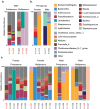Delivery mode, birth order, and sex impact neonatal microbial colonization
- PMID: 40251947
- PMCID: PMC12013413
- DOI: 10.1080/19490976.2025.2491667
Delivery mode, birth order, and sex impact neonatal microbial colonization
Abstract
The initial microbial colonization of the infant gut during birth plays a critical role in shaping both immediate and long-term health outcomes. While mode of delivery is a known determinant of this colonization process, the potential impacts of infant sex and birth order remain underexplored. This study investigates the influence of delivery mode, infant sex, and birth order (maternal parity) on the microbial communities in first-pass meconium samples from neonates, using 16S rRNA gene sequencing. We found that delivery mode impacted the presence of detectable microbial communities. Specifically, only 17% of samples from neonates delivered by elective Cesarean section showed any microbial presence, compared to approximately two-thirds of samples from neonates exposed to maternal vaginal microbes (emergency C-section or vaginal delivery). Among vaginally delivered neonates without antibiotic exposure, birth order was associated with taxonomic shifts. Neonates born to primiparous mothers had a lower abundance of Bifidobacterium, a keystone species in the infant gut microbiome. Unexpectedly, the gut microbiota differed by infant sex, with males having lower alpha diversity and shifts in microbial community composition (PERMANOVA p = 0.008), characterized by elevated levels of Enterobacteriales, which was both less prevalent and less abundant in female neonates. These findings highlight the intricate interplay between delivery mode, infant sex, and birth order in shaping the early gut microbiome.
Keywords: Gut microbiota; birth mode; birth order; delivery mode; first-pass meconium; infant sex; neonatal colonization; parity.
Conflict of interest statement
No potential conflict of interest was reported by the author(s).
Figures



Similar articles
-
The influence of maternal gut and vaginal microbiota on gastrointestinal colonization of neonates born vaginally and per caesarean section.BMC Pregnancy Childbirth. 2025 Mar 8;25(1):254. doi: 10.1186/s12884-025-07358-w. BMC Pregnancy Childbirth. 2025. PMID: 40057706 Free PMC article.
-
Maturation of the infant microbiome community structure and function across multiple body sites and in relation to mode of delivery.Nat Med. 2017 Mar;23(3):314-326. doi: 10.1038/nm.4272. Epub 2017 Jan 23. Nat Med. 2017. PMID: 28112736 Free PMC article.
-
Comparison of Gut Microbiomes Between Neonates Born by Cesarean Section and Vaginal Delivery: Prospective Observational Study.Biomed Res Int. 2024 Nov 28;2024:8302361. doi: 10.1155/bmri/8302361. eCollection 2024. Biomed Res Int. 2024. PMID: 39640900 Free PMC article.
-
Gut Microbiota Composition in Healthy Japanese Infants and Young Adults Born by C-Section.Ann Nutr Metab. 2018;73 Suppl 3:4-11. doi: 10.1159/000490841. Epub 2018 Jul 24. Ann Nutr Metab. 2018. PMID: 30041174 Review.
-
Unveiling the neonatal gut microbiota: exploring the influence of delivery mode on early microbial colonization and intervention strategies.Arch Gynecol Obstet. 2024 Dec;310(6):2853-2861. doi: 10.1007/s00404-024-07843-1. Epub 2024 Nov 26. Arch Gynecol Obstet. 2024. PMID: 39589476 Review.
References
-
- Dominguez-Bello MG, Costello EK, Contreras M, Magris M, Hidalgo G, Fierer N, Knight R. Delivery mode shapes the acquisition and structure of the initial microbiota across multiple body habitats in newborns. Proc Natl Acad Sci USA. 2010;107(26):11971–11975. doi: 10.1073/pnas.1002601107. - DOI - PMC - PubMed
-
- Ferretti P, Pasolli E, Tett A, Asnicar F, Gorfer V, Fedi S, Armanini F, Truong DT, Manara S, Zolfo M, et al. Mother-to-infant microbial transmission from different body sites shapes the developing infant gut microbiome. Cell Host & Microbe. 2018;24(1):133–145.e5. doi: 10.1016/j.chom.2018.06.005. - DOI - PMC - PubMed
MeSH terms
Substances
LinkOut - more resources
Full Text Sources
Medical
